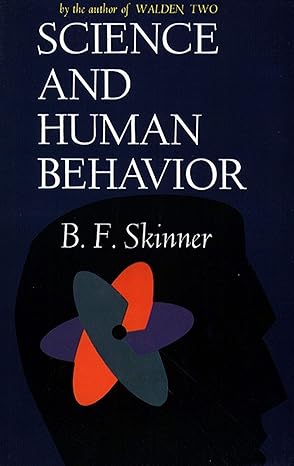Written by Rick Kubina
At some level, everyone has a stake in changing and influencing behavior. In fact, we all do it every day.
If you drive to work, every time you use a turn signal or beep your horn, your actions have an effect on fellow drivers. When we greet people, ask for advice, or use manners, our behavior exerts differential control on others.
A parent hugging a child, expressing approval, or handing over allowance shows the power of influence in action. But to make sense of behavior and mold it fruitfully requires a science of behavior. For years pop-psychology and discredited models of causation for behavior have littered the landscape (e.g., Freud’s Ego, Superego, and Id).
The following four books serve as a gateway for people who want to leverage science to understand behavior and formulate plans to successfully change it.

Science and Human Behavior (1953) by B.F. Skinner
The core of changing behavior resides in understanding why it happens. No small task! For years psychology has attempted to study the mind and offer a number of different theories explaining why people do what they do.
Skinner came along and brilliantly set up a science focused on what we could see – behavior. No need for exotic theories based on constructs or appeals to the unobservable mind.
In Science and Human Behavior Skinner laid out chapter by chapter what an observational science concentrated on behavior provided us. For example, in Chapter 8, The Controlling Environment, Skinner wrote: “No matter what our philosophy of behavior may be, we are not likely to deny that the world around us is important. We may disagree as to the nature or extent of the control which it holds over us, but some control is obvious” (Skinner, 1953, p. 129),
Understanding the controlling variables helps society concerned with behavior engineer a brighter future. In school, two principals could implement different systems geared towards getting students to behave in a particular manner, one based on punishment and avoidance of negative consequences or one based on positive reinforcement. Which school would you rather send your child to? Now expand that thought to society.
Behavior analysis has grown in complexity since the publication of Science and Human Behavior, but like Darwin’s On the Origin of Species, Skinner’s work still rings true today and changed the course of an entire science.

Analyzing Instructional Content
By P. Tiemann and S. Markle
Science makes great use out of taxonomies. As an example, you may recall the Linnaean taxonomy for classifying life. The taxonomy starts with the broad category of Kingdom (e.g., Animals) and works it way to Species (e.g., Felis catus).
The value of classification holds true in the science of learning as well. “What teachers teach is just as important as how it is taught … having a clear understanding of what is taught ultimately helps the teacher decide how it should be taught” (Kameenui & Simmons, 1990, p. 58). Therefore, a taxonomy of learning helps instructional designers orchestrate effective educational and behavior change programs.
Tiemann and Markle offer an interesting, useful taxonomy of learning. The broad categories include emotional learning, psychomotor learning, and simple and complex cognitive learning. The text further expands to subcategories.
Absorbing the different categories and subcategories of learning help teachers effectively arrange instruction so students can efficiently learn to tie their shoes, keyboard words, balance chemical equations, and apply the scientific method.

What Shamu taught me about life, love, and marriage (2009)
By Amy Sutherland
Like other sciences (e.g., biology, physics), some people do not fully understand behavior analysis and misinterpret concepts. For instance, positive reinforcement becomes bribery. Others may hear about part of the science and make claims such as “behavior analysis is all about shocking animals and punishing people.”
Yet from the beginning, the founder of behavior analysis, B. F. Skinner, stridently opposed punishment. Also, an entire branch of behavior analysis devotes itself to the betterment of humankind, called Applied Behavior Analysis.
In What Shamu taught me about life, love, and marriage, Sutherland shows how behavioral techniques enhance and deepen relationships without the need for punishment. An excellent chapter titled “Why I stopped nagging” forms a perfect example of using positive consequences to make life better.
Handbook of the Standard Celeration Chart (2003)
By H. S. Pennypacker, A. Gutierrez, and O. R. Lindsley
Perhaps no other graph receives more attention than the line graph. Business analysts (e.g., interest – profits), governmental organizations (e.g., interest – voter attitudes), psychologists (e.g., interest – depressive thoughts), and anyone else concerned with change across time often make use of line graphs.
Line graphs fall under the banner of time-series analysis. Perhaps the most powerful visual system for displaying behavior across times comes in the form of the Standard Celeration Chart.
Pennypacker, Gutierrez, and Lindsley have written a handbook that shows how we can quantify behavior, examine it in a standard manner, and make important decisions. With the stakes so high for decision making, all human service providers deserve an option for using such a powerful tool like the Standard Celeration Chart.
Conclusion
Many important works exist which help us understand why behavior occurs and how we might change it. The previous four books deliver content critical for behavior change along the following dimensions:
- Why does behavior occur and what does science tell about it: Science and Human Behavior
- How do we classify behavior so that we may arrange effective teaching sequences: Analyzing Instructional Content
- What techniques of behavioral change dignify our fellow humans and provide a positive atmosphere for all involved: What Shamu taught me about life, love, and marriage
- What statistical graphic for time series best displays behavior and facilitates decision making: Handbook of the Standard Celeration Chart
What are your go to books on behavior? Post in the comments, we’d love your feedback.
References
Kameenui, E. J., & Simmons, D. C. (1990). Designing instructional strategies: The prevention of academic learning problems. Englewood Cliffs, NJ: Macmillan.
Pennypacker, H. S., Gutierrez, A., & Lindsley, O. R. (2003). Handbook of the Standard Celeration Chart. Cambridge, MA: Cambridge Center for Behavioral Studies.
Skinner, B. F (1953). Science and human behavior. New York: Free Press.
Sutherland, A. (2009). What Shamu taught me about life, love, and marriage: lessons for people from animals and their trainers. NewYork: Random House.Tiemann, P.W., & Markle, S. M. (1990). Analyzing instructional content: A guide to instruction and evaluation (4th ed.). Champaign, IL: Stipes Publishing Company.






